Paints to use when starting a painting (more transparent, dry quickly)
For Trees, buildings, etc:
Ultramarine Blue
Prussian Blue (good for the ocean)
Dioxazine Purple
Yellow Ochre
Viridian Green
Sap Green
Alizarine Crimson
Burnt Sienna
Burnt Umber
Indian Yellow (very strong clear transparent yellow)
Permanent Rose
Quinacridone Magenta
For sky areas and for a sense of distance (use sparingly):
Naples Yellow
White
Cobalt Turquoise (good for ocean and underwater seafoam)
Paints to use only later in the process (very opaque, dry very slowly):
Cadmium Yellow Light (or Cad. Lemon or Hansa Yellow)
Cad. Yellow Medium or Dark
Cadmium Orange
Cadmium Red Light, Medium, and/or Dark
Cad Light Green
Permanent Green
any Gamblin Radiant Series
Regard the scene (or still life or figure). See if you can “grok” the overall dance or movement of what’s going on. Is there a focal point of interest? Is there a path going into the space? (consider inventing one if there is not!) Does the space between things do any special movement? (i.e. a tunnel of space over a shady lane, or a sweep of air along a coastline, or mysterious glades among treetrunks...) What emotion is expressed by this scene? Squint if it helps to see the larger masses and the overall pattern. If the light is doing something truly amazing, take a picture now since those effects rarely last! Same thing with animals or people doing interesting things in your scene.
Step 1: Dot paint directly from tubes onto canvas for quickest results. Your choice of color now will set the tone for the whole painting. Balance observation with fantasy and imagination regarding color! Use your largest brush to mush paint into approximate shapes without regard to lighting effect, just simplified silhouettes. Let the tones be in the middle, neither very light nor very dark. Cover the canvas completely with thinned paints, using either turpentine or turps mixed with some dryer. Borrow paint with your brush from heavier areas if needed to distribute and re-arrange. Note that more distant objects are lighter in tone, so add white or let the paint be more transparent.
When the whole canvas is covered, take a moment to congratulate yourself. Eat a cookie and drink a sip of your hot tea.
Step 2: Use a medium size brush dipped in darker paints to draw shadows and structural details. Adjust the darkness so more distant objects are sketched in lighter tones. This would be the time to add the more important tree trunks and branches.
Step 3: Then take a rag in one hand and dip a smaller clean brush in thinner. A t-shirt rag on your finger works well for this step, or just keep re-cleaning the brush. Start wiping away areas where the sun directly hits the objects: rooftops, tree bulges facing the sky, sunlight patches on a road surface or a lawn, linear streaks along tree trunks facing the light.
If the canvas has been toned a deep color, this step may take some imagination and delayed gratification since you are working to achieve a sense of light.
Step 4: Start adding highlights using strong, thick opaque paints. Now’s the time for cadmiums. Sunlight is yellow, and so a stronger effect of light can be achieved with yellow tints. White clouds can have a pure yellow edge to pop them against the blue sky. Tree trunk highlights can have a cadmium orange edge to pop them against all the green and blue shadows. Road highlights can be pink, yellow or orange depending on the paving material. Lawns and trees can have pure yellow or cadmium green light highlights. Permanent Green can be used sparingly. The Gamblin Radiant Series can be helpful.
Time and energy permitting, the final working of the painting can go on to whatever level of exactitude you prefer. Take photos of the scene if you like so you can tweak the details later. But oftentimes the first bold approach will result in a fresh, exciting painting that might not be improved with a lot of fussing!
Thanks as always to Roger Montoya of New Mexico for always generously sharing his techniques!
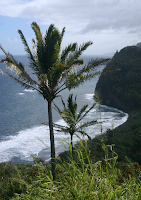
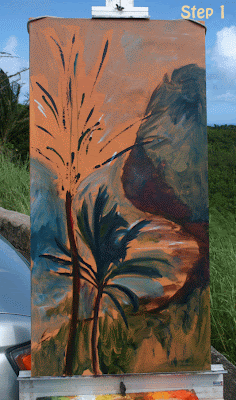
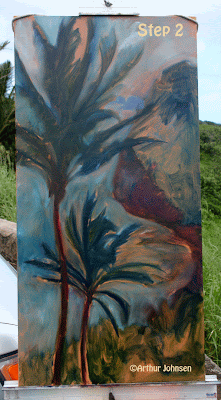
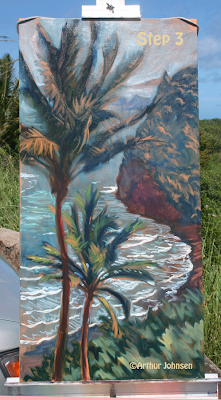
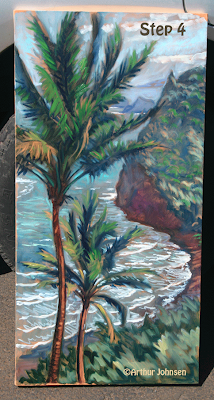
No comments:
Post a Comment